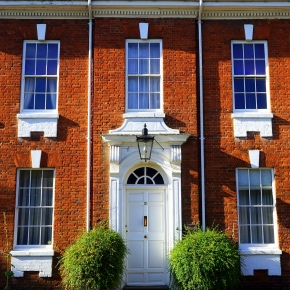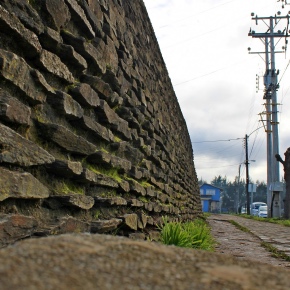
The building blocks of Britain: How to maintain your heritage brickwork
Despite being one of the strongest building materials, brick will still fail if it is not looked after properly. Making repairs with the wrong mortar, or applying poorly matched paints or sealants to the exterior are common culprits for brickwork woes. Similarly, allowing damaged gutters to leak water down the façade, or not attending to cracks caused by structural movement can lead to bigger problems.
Homes built using bricks made before 1919 should not be exposed to the same treatments as later constructions, as the masonry’s porosity will struggle against modern materials. Inhibiting your home’s “breathability” is a common cause for damp and decay in an older property, while proper maintenance will ensure your building stands for generations to come.
British Brickwork: A History
 Over the generations, the styles and finishes of British bricks and brickwork have varied greatly, making it easy to spot the relics of distinctive architectural eras. Early bricks are irregular in size and finish, which become more consistent as decades continue. In the Georgian era (1714 to 1830), manufacturing technology advanced to allow mass-production of the regimented, symmetrical bricks commonly associated with the period.
Over the generations, the styles and finishes of British bricks and brickwork have varied greatly, making it easy to spot the relics of distinctive architectural eras. Early bricks are irregular in size and finish, which become more consistent as decades continue. In the Georgian era (1714 to 1830), manufacturing technology advanced to allow mass-production of the regimented, symmetrical bricks commonly associated with the period.
Typically made from clay, bricks have been historically formed by hand, using timber moulds. When building, bricks would be held together using a porous lime or earth mortar, which allowed a certain amount of air and moisture between the materials for the building to “breathe”. By the end of World War I, buildings were being made from the less-porous bricks and mortar we still use today.
Signs of Failing Brickwork
Crumbling brickwork may be the sign of recent mistreatment, or the symptom of years of neglect. Either way, the first step to fixing the problem is to identify it.
Look for:
- Bricks which are crumbling, spalling or cracking
- Water stains leading from drains or gutters
- Pointing which is becoming loose, or missing altogether
- Damp patches internally or externally
- Bulging walls or subsidence
- The use of inappropriate paints or sealant
Before taking drastic measures, failing bricks should be evaluated by architectural conservation experts who will be able to recommend the most appropriate measures to take for your specific property. The type of remedial work will depend on whether the damage is superficial, or if it suggests further decay within the building. A specialist will be able to help you keep your costs down and your building upright.
Pointing Deterioration
If the pointing of your bricks is cracking or crumbling, this should be addressed as early as possible. The small gaps left behind by missing pointing will cause water to pool and potentially penetrate through into the building.
Where modern cement has been used to patch previously failed pointing, you may find that moisture has been trapped behind the materials and is causing internal dampness rather than evaporating as it once would have. Moisture gets trapped inside the bricks, and if left untreated, will damage their integrity when the temperature drops below freezing.
Failed pointing will need to be carefully removed and replaced with a suitable lime mortar. While it’s not impossible to complete repointing yourself, the task requires considerable patience so hiring a skilled tradesman will be a less stressful solution.
Distorted bricks
Over time, many buildings continue to settle, so cracked bricks or bulging walls should not necessarily trigger alarm bells. The porous materials like clay and lime allow for a certain amount of movement, and a readjusting building will not immediately fall down.
To set your mind at ease, look for the cause of potential load-shifting. For example, timber frames which are beginning to rot or perish, forcing more strain on the surrounding brickwork. Bricks soaked by damaged guttering can also become weak, and the roots of nearby trees are notorious for causing problems. If the cause of the distortion is not clear, it’s best to consult a structural engineer with experience in historic homes.
Cleaning your Brickwork
Cleaning a modern home is relatively straightforward; simply attach a pressure washer nozzle to your garden hose and get blasting. Older homes, with their delicate woodwork and handmade bricks, need a little more care. Cleaning them with a too-abrasive method will quickly result in damage, ultimately speeding up the building’s demise.
A garden hose without a high-pressure nozzle can loosen dirt and grime, and will be much gentler on your brickwork. Give particularly dirty bricks a few seconds under the flow, and give it a light brush with soft bristles. Chemical cleaning may be effective, but take care not to stain your exterior. Be aware that certain cleaning methods may leave efflorescence (see below).
Whichever method you choose to clean your property, make sure to test it in a small, unobtrusive area first. If large areas are covered in a hard-to remove substance (like paint), skip the DIY and call a specialist.
Efflorescence
If the water passing through the bricks contains dissolved salt or mineral deposits, these can get left behind on brickwork when the water evaporates. The resulting blossoms are known as “efflorescence”. While not especially attractive, efflorescence does not usually pose a threat to the integrity of your brickwork.
If you want to get rid of efflorescence, resist the temptation to try and wash it off – the water will simply evaporate again and leave the same (or worse) marks behind. Instead, use a medium brush or vacuum cleaner to loosen the deposits, and identify the source of the water to prevent the problem reoccurring.
This article was written by Dakota Murphey.
Latest news

24th April 2024
The lowdown on Origin’s New Soho Offering
Origin’s Soho External Door is the first launch in its new generation of products, setting a higher standard for the fenestration industry.
Posted in Access Control & Door Entry Systems, Aluminium Products, Architectural Ironmongery, Articles, Building Industry News, Building Products & Structures, Building Systems, Doors, Innovations & New Products, Posts, Restoration & Refurbishment, Retrofit & Renovation, Security and Fire Protection
24th April 2024
Mitsubishi Electric welcomes new code of conduct for smart appliances
Mitsubishi Electric welcomes a new code of conduct on energy smart appliances which the European Union (EU) announced yesterday at the Hannover Fair in Germany.
Posted in Air Conditioning, Articles, Building Industry Events, Building Industry News, Building Products & Structures, Building Regulations & Accreditations, Building Services, Exhibitions and Conferences, Facility Management & Building Services, Heating Systems, Controls and Management, Heating, Ventilation and Air Conditioning - HVAC, Plumbing, Retrofit & Renovation, Seminars, Sustainability & Energy Efficiency
24th April 2024
Hamworthy Heating expands CIBSE approved CPD modules with new hot water series
Hamworthy Heating, technical experts in commercial heating and hot water products, announce the expansion of its market leading CIBSE approved Continuing Professional Development (CPD) portfolio with the launch of three new learning modules.
Posted in Articles, Building Industry Events, Building Industry News, Building Products & Structures, Building Services, Continuing Professional Development (CPD's), Facility Management & Building Services, Heating Systems, Controls and Management, Heating, Ventilation and Air Conditioning - HVAC, Plumbing, Retrofit & Renovation, Seminars, Training
24th April 2024
New technology partnership brings Passivent ventilation products to IESVE
Passivent has partnered with Integrated Environmental Solutions (IES) to make a number of its products available to model within the Virtual Environment (VE) platform IESVE.
Posted in Air Conditioning, Articles, Building Industry News, Building Products & Structures, Building Services, Facility Management & Building Services, Heating, Ventilation and Air Conditioning - HVAC, Information Technology, Innovations & New Products, Posts, Retrofit & Renovation, Roofs, Ventilation
 Sign up:
Sign up: